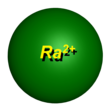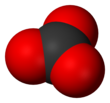Radium carbonate is a chemical compound of radium, carbon, and oxygen, having the chemical formula RaCO3. It is the radium salt of carbonic acid. It contains radium cations (Ra2+) and carbonate anions (CO2−3). This salt is a highly radioactive, amorphous,[4] white powder that has potential applications in medicine.[5][2] It is notable for forming disordered crystals at room temperature and for being approximately 10 times more soluble than the corresponding barium carbonate - witherite.[4] Radium carbonate is one of a few radium compounds which has significantly different properties from corresponding barium compounds. Moreover, radium is the only alkaline-earth metal which forms disordered crystals in its carbonate phase. Even though radium carbonate has very low solubility in water, it is soluble in dilute mineral acids and concentrated ammonium carbonate.[6]
| |||
| Names | |||
|---|---|---|---|
| IUPAC name Radium carbonate | |||
| Identifiers | |||
3D model (JSmol) | |||
| |||
| |||
| Properties | |||
| RaCO3[2] | |||
| Molar mass | 286.0089 g/mol[3] | ||
| Appearance | white powder[2] | ||
| insoluble[2] | |||
| Hazards | |||
| Occupational safety and health (OHS/OSH): | |||
Main hazards | radioactive | ||
| Related compounds | |||
Other cations | |||
Except where otherwise noted, data are given for materials in their standard state (at 25 °C [77 °F], 100 kPa). | |||
Preparation
Radium carbonate can be produced by dissolving radium sulfate at elevated temperatures in concentrated sodium carbonate and subsequent removal of supernatant:[7]
- RaSO4(s) → Ra2+ + SO2−4
- Ra2+ + CO2−3 → RaCO3(s)
Because of the very low solubility of RaCO3, it will form a white precipitate.
Reactions
Radium carbonate can be used to produce radium nitrate and other radium salts:
- RaCO3 + 2 HNO3 → Ra(NO3)2 + H2O + CO2

